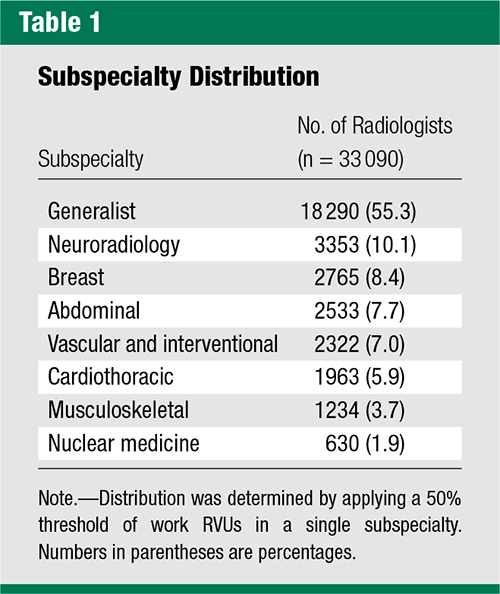Study Shows More than Half Radiologists are Generalists vs. Subspecialists
Researchers point to location, length of time in practice and gender as factors in the decision whether to subspecialize


Understanding the U.S. workforce of more than 30,000 radiologists is crucial for institutions planning training programs, practices making staffing decisions and patients looking for a doctor who can meet their needs.
It is a subject that Richard Duszak, MD, professor and vice chair for Health Policy and Practice, Department of Radiology and Imaging Science, Emory University, Atlanta, and Andrew B. Rosenkrantz, MD, professor and director of Health Policy at New York University (NYU) Langone Health, have been researching for a number of years.
The most recent study by Drs. Duszak, Rosenkrantz and colleagues, “Generalist versus Subspecialist Characteristics of the U.S. Radiologist Workforce,” was published online in Radiology.
“Overall, the goal is making sure we right-size our radiology workforce and provide the best services to our patients at the right time,” Dr. Duszak said. “It all sounds a lot easier than it is.”
In their study, researchers determined that while there has been an increased focus on radiology subspecialization, 55 percent of radiologists predominantly practice as generalists.
“While there is a lot of talk about increasing radiologist subspecialization, we have to recognize that generalists still represent slightly over half of radiologists practicing today,” said Dr. Rosenkrantz, who also serves as section chief of abdominal imaging and director of prostate imaging at NYU.
The research combined a variety of public datasets to study 33,090 radiologists across the country who billed Medicare between 2012 and 2014. Researchers used a validated classification system to map services to seven subspecialties and quantify subspecialty-focused work on the basis of relative value units (RVUs). Radiologists with more than half of their billed work RVUs in a single subspecialty were designated subspecialists; the remainder of radiologists were classified as generalists.
Among radiologists practicing as majority subspecialists, neuroradiologists (10 percent of all radiologists) and breast imagers (8.4 percent) were the most common, the study showed.
“Right-Sizing” the Radiology Workforce
Dr. Duszak said that variables including where doctors are trained and choose to live versus where patients live and the types of services they need can lead to a mismatch in the radiologist/patient relationship. Dr. Duszak defines “right-sizing” as “matching patient needs to physician talent, no matter where they live.”
While many radiology thought leaders are pushing for more focused subspecialization, which can be successful at a large academic or research institution in an urban environment, that focus is not always the best approach in other parts of the country.
“If a patient lives in a rural area with only five radiologists covering a portion of a state, not everyone can be subspecialized,” Dr. Rosenkrantz said. “The idealistic answer may be that everyone is a subspecialist. The realistic answer is that a robust generalist radiologist workforce is needed to provide proper coverage and imaging to people all over the country.”
Length of time practicing, the size and location of the practice, gender and academic status were all factors in a radiologist's decision to subspecialize or not, the study showed. For example, radiologists with fewer years in practice were more likely to subspecialize.
And while slightly more than half of the nation’s radiologists practice as generalists, those doctors still devote about one-third of their time to a specific subspecialty as well, the study found.
“Radiologists who are just finishing training today can look at this research and understand that they should be prepared to handle more than just that one subspecialty and that their jobs might change over time,” Dr. Rosenkrantz said.

Web Extras
- Access the study, "Generalist versus Subspecialist Characteristics of the U.S. Radiologist Workforce" at https://pubs.rsna.org/doi/abs/10.1148/radiol.2017171684